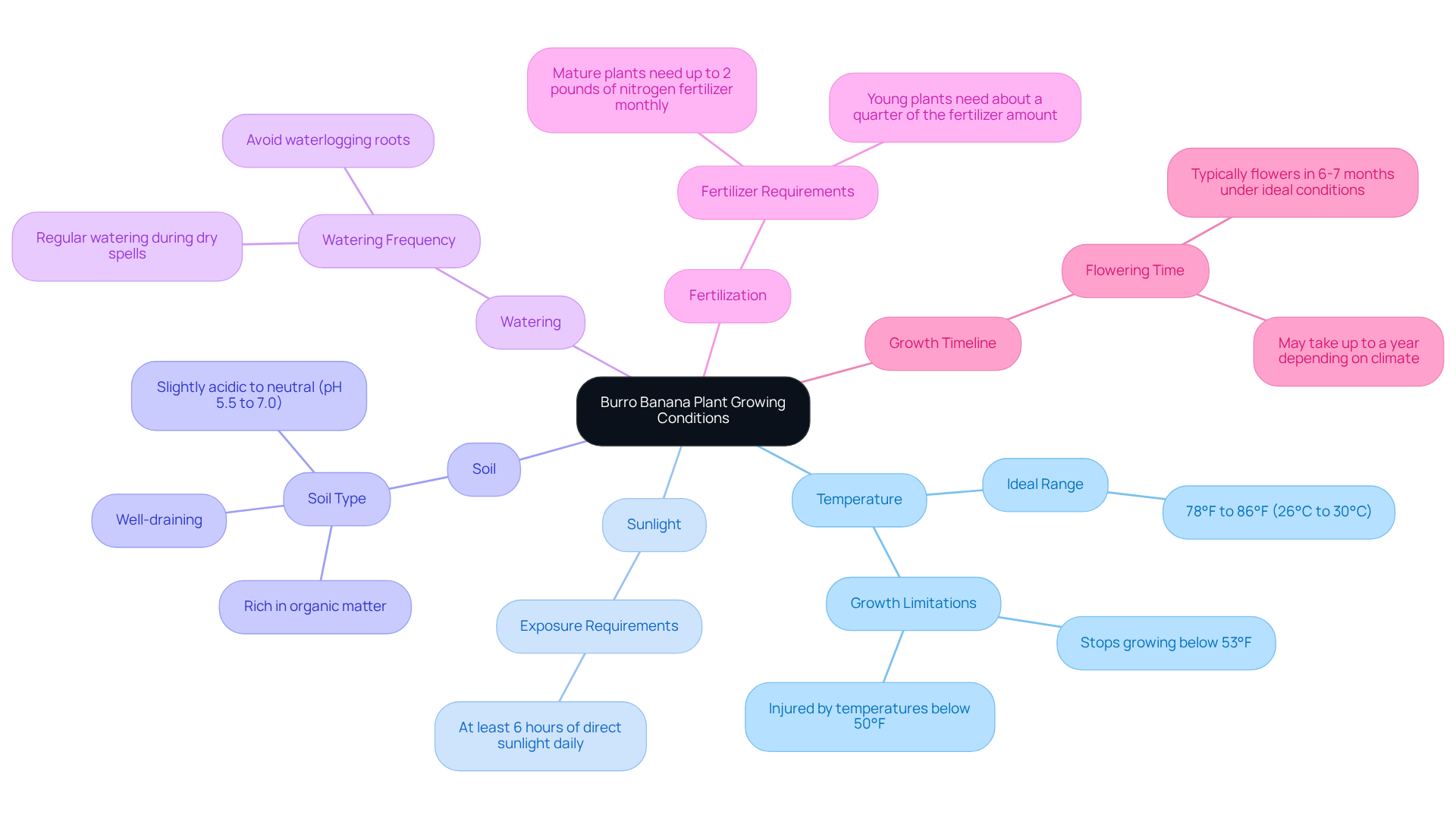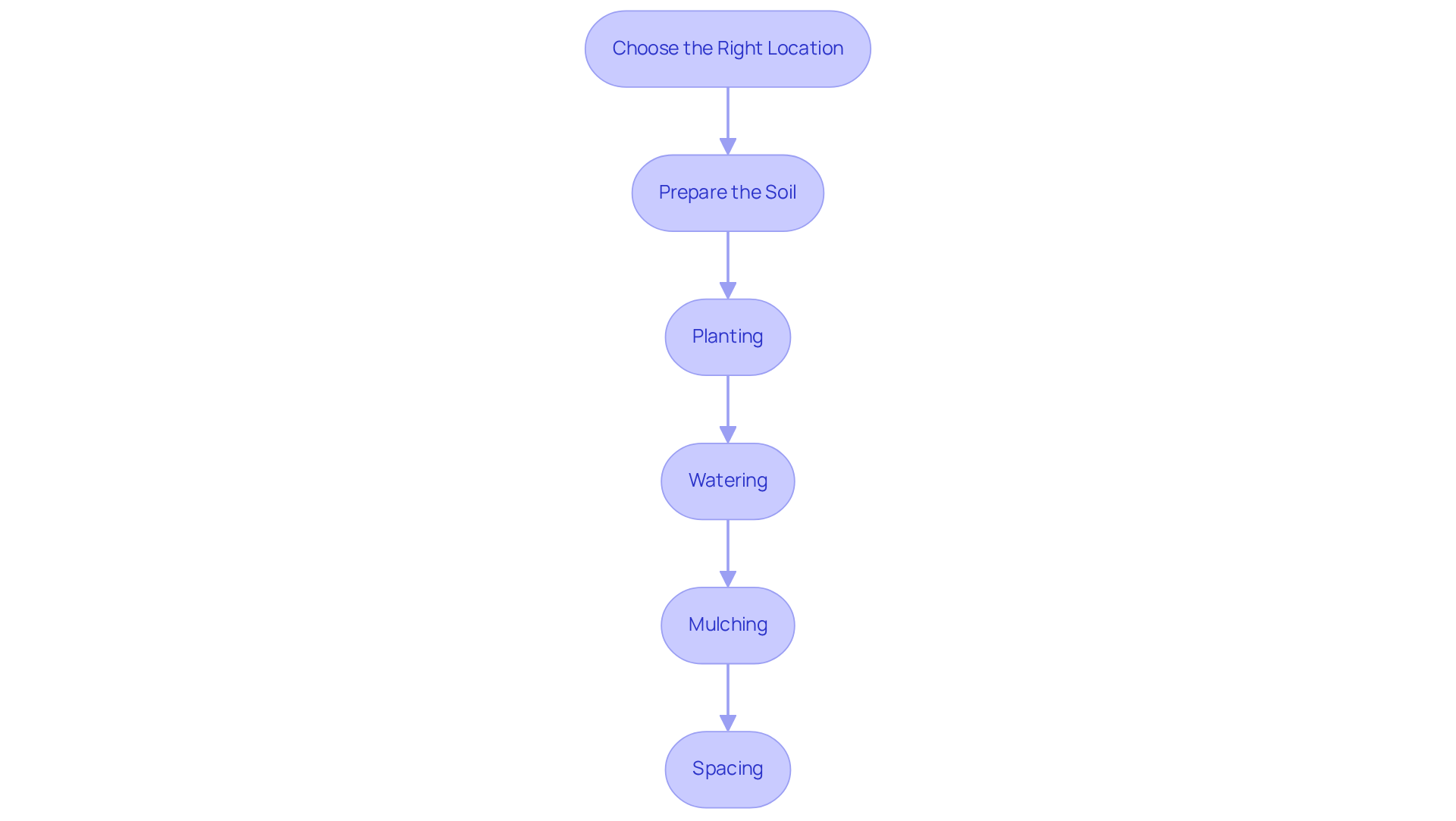The Burro banana plant, celebrated for its distinctive flavor and resilience, presents an appealing opportunity for both novice and experienced gardeners. By grasping the specific growing conditions and maintenance requirements, enthusiasts can successfully cultivate these tropical beauties. However, the path to a fruitful harvest often presents challenges, ranging from pest management to nutrient deficiencies.
🍌 Thinking about growing a Banana Tree in your garden?
Explore Burro Banana Plant for sale at Everglades Farm - shipped directly from Florida.
How can gardeners effectively navigate these complexities to ensure the thriving of their Burro banana plants?
1. Understand the Growing Conditions for Burro Banana Plants
Burro bananaplant thrives in warm, humid environments, with ideal temperatures ranging from 78°F to 86°F (26°C to 30°C). They require full sun exposure, receiving at least six hours of direct sunlight daily. The soil should be , well-draining, and slightly acidic to neutral, with a pH of 5.5 to 7.0. Bananas flourish best on level ground with a gradient of 0-1%, which is crucial for their development.
Regular watering is essential, particularly during dry spells, to maintain consistent moisture without waterlogging the roots. Additionally, incorporating compost or well-decomposed manure can significantly enhance soil fertility, promoting vigorous growth and fruiting. It's important to note that young varieties of the fruit require approximately a quarter of the fertilizer quantity needed by fully grown specimens.
Furthermore, fruit plants may take up to a year to flower, depending on the climate, which is a critical aspect of understanding their growth timeline. By following these guidelines, gardeners can ensure the healthy development of burro bananaplant.

2. Plant Your Burro Banana: Step-by-Step Instructions
- Choose the Right Location: Selecting a sunny spot that receives at least 6 to 8 hours of sunlight daily and has well-draining soil is essential. Avoid regions susceptible to waterlogging, as this fruit flourishes in consistently moist but not saturated conditions. For soursop trees, ensure the location is sheltered from strong winds, as they can be sensitive to harsh weather.
- Prepare the Soil: To prepare the planting area, dig a hole twice as wide and the same depth as the root ball of your burro bananaplant. In sandy earth, blend the top layer or compost with local earth in a 50-50 ratio to enhance it, supplying essential nutrients and improving drainage. For soursop, incorporate organic matter to improve ground fertility, which is vital for healthy growth.
- Planting: When planting, place the plant in the hole, ensuring the top of the root ball is even with the surrounding earth. Backfill the hole with the prepared earth mixture, gently compacting it around the roots to remove air pockets. For soursop, spread the roots evenly in the hole to encourage healthy development.
- Watering: After planting, irrigate the vegetation thoroughly to help settle the soil. Maintain consistent moisture by providing 1 to 1.5 inches of water weekly, ensuring it remains damp but not soggy, as bananas need ample water for optimal development. Soursop trees also benefit from regular watering, especially during dry spells, to support fruit development.
- Mulching: Applying a 4-inch layer of organic mulch around the base of the plant helps retain moisture in the ground, suppress weeds, regulate temperature in the earth, and create a favorable environment for growth. For soursop, mulch can also help prevent soil erosion and maintain nutrient levels.
- Spacing: When arranging several burro bananaplant fruit plants, ensure they are . This distance allows for their mature size and ensures adequate air circulation, reducing the risk of disease. Common spacing options for these crops vary from 2 to 5 meters. Similarly, when planting soursop trees, maintain adequate spacing to allow for their expansive growth and minimize competition for nutrients.

3. Maintain Your Burro Banana Plant: Care and Maintenance Tips
- Watering: It is essential to provide your burro bananaplant with , especially during dry spells. Banana plants typically require about 4-10 inches (100-250 mm) of water monthly, with crop water demand ranging from 1200 mm to 2690 mm per year. Thorough watering is vital to promote robust root growth; therefore, avoid allowing the soil to dry out completely.
- Fertilization: Establish a fertilization schedule by applying a balanced fertilizer, such as a 10-10-10 formulation, every 4 to 6 weeks throughout the growing season. This approach supplies the necessary nutrients for healthy growth. Additionally, consider organic alternatives like compost tea, which can enhance soil fertility and plant vitality. Effective nutrient management is critical for improving banana crop yields and overall health.
- Pruning: Regularly remove any dead or damaged leaves to enhance airflow around the plants, thereby reducing the risk of disease. It is also advisable to prune back suckers that emerge from the base, allowing the plant to concentrate its energy on fruit production, which ensures a more abundant harvest.
- Pest Management: Conduct routine inspections for pests, such as aphids and spider mites. If infestations occur, employ organic insecticidal soap or neem oil to effectively manage and control these pests without harming the plants.
- Mulching: Apply a layer of mulch around the base of the burro bananaplant species. This practice helps retain moisture, suppresses weed growth, and regulates temperature, creating an optimal environment for growth. As agronomists have noted, maintaining proper moisture levels and temperature—ideally between 79°F (26°C) and 86°F (30°C)—is crucial for the health of banana plants.

4. Troubleshoot Common Issues with Burro Banana Plants
- Yellowing Leaves: Yellowing leaves can indicate issues such as overwatering or nutrient deficiencies. To address this, first check the moisture levels; if the soil is too wet, allow it to dry out. If you suspect a nutrient deficiency, applying a balanced organic fertilizer can help restore the plant's health.
- Wilting: Wilting leaves typically signify underwatering or root rot. Ensure your plants receive adequate water, generally around 0.5 cups every 9 days for potted varieties. Additionally, inspect the roots for signs of rot, which may require repotting in fresh, well-drained soil. Remember to transfer tropical species once they have increased in size to promote vigorous development.
- Common nuisances, such as aphids and weevils, can harm your vegetation. Routine examinations are crucial; if you discover infestations, promptly address them using organic pest management techniques to protect your burro bananaplant crops.
- Diseases: Fungal diseases, like Black Sigatoka, can pose significant threats to your plants. To minimize these risks, ensure around your vegetation and avoid overhead watering, which can create a damp environment conducive to disease.
- Fruit Drop: Premature fruit drop may occur due to stress from inconsistent watering or nutrient deficiencies. Maintaining a consistent watering schedule and ensuring proper fertilization are essential to support healthy fruit development. Note that it typically takes about 3 months for fruits to appear after planting, so patience is vital.
- Burro bananaplant thrive in abundant, bright, and direct sunlight for optimal growth. Ideally, position them less than 1 foot from a window to ensure they receive the necessary sunlight.
Conclusion
Successfully nurturing a Burro banana plant requires a comprehensive understanding of its specific needs and conditions. By focusing on the right environment, proper planting techniques, and ongoing care, gardeners can foster healthy growth and fruitful yields. The journey from planting to harvesting involves crucial steps that, when followed, ensure the plant thrives in its optimal conditions.
This guide outlines essential elements such as:
- Selecting the ideal location
- Preparing the soil
- Maintaining consistent watering practices
It emphasizes the importance of:
- Regular fertilization
- Pest management
- Troubleshooting common issues like yellowing leaves or wilting
Each of these factors plays a significant role in the overall health and productivity of the Burro banana plant, highlighting the need for diligence and care throughout the growing process.
Gardening enthusiasts are encouraged to embrace these techniques and insights to cultivate their own Burro banana plants with confidence. By applying the knowledge shared in this guide, one can not only enjoy the fruits of their labor but also contribute to sustainable gardening practices. The path to successful Burro banana cultivation is paved with informed choices and dedicated care, ensuring a bountiful harvest for years to come.
Cultivate Your Tropical Paradise Today!
Start your journey with Everglades Farm and watch your Burro bananas flourish.
🛒 Buy Burro Banana Plant
🍌 Explore the banana trees collection
Frequently Asked Questions
What are the ideal growing conditions for Burro banana plants?
Burro banana plants thrive in warm, humid environments with ideal temperatures ranging from 78°F to 86°F (26°C to 30°C). They require full sun exposure, receiving at least six hours of direct sunlight daily.
What type of soil is best for Burro banana plants?
The soil should be rich in organic matter, well-draining, and slightly acidic to neutral, with a pH of 5.5 to 7.0.
What is the preferred terrain for growing Burro banana plants?
Bananas flourish best on level ground with a gradient of 0-1%, which is crucial for their development.
How often should Burro banana plants be watered?
Regular watering is essential, particularly during dry spells, to maintain consistent moisture without waterlogging the roots.
How can soil fertility be improved for Burro banana plants?
Incorporating compost or well-decomposed manure can significantly enhance soil fertility, promoting vigorous growth and fruiting.
Do young Burro banana plants require the same amount of fertilizer as fully grown plants?
No, young varieties of the fruit require approximately a quarter of the fertilizer quantity needed by fully grown specimens.
How long does it take for Burro banana plants to flower?
Fruit plants may take up to a year to flower, depending on the climate, which is a critical aspect of understanding their growth timeline.





0 comments